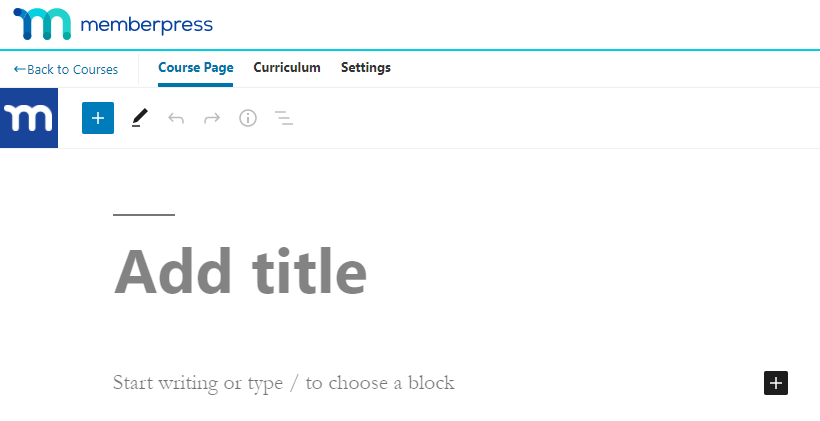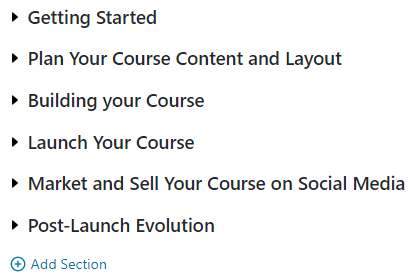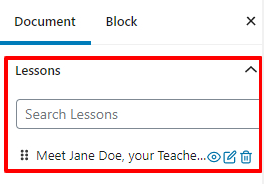Getting Started with MemberPress Courses
Video Tutorial:
Install the Courses Add-on
First, you'll need to install the MemberPress Courses add-on by visiting the MemberPress menu > Courses page in your WordPress dashboard. If you don't see the MemberPress > Courses menu item, you may need to update the MemberPress plugin to the latest version.
Next, locate the Courses add-on and click to install it. Again, if you don't see the Courses add-on listed, ensure your license key is up to date and activated on the MemberPress settings page, or try refreshing the add-ons.

After installing the add-on, it will be activated on your site. Then, you'll be redirected back to the Courses page, where you can create your first Course.
Create Your First Course
Now you're ready to create your very first course. If you don't have your content/layout fully put together, pause and take a few minutes to write down your course title, section headings, and the name of each lesson. (You might want to check out this post on the MemberPress blog: How To Create A Solid Online Course for your Membership Site.)
Next, visit your new MemberPress > Courses page, and you'll see the following buttons at the top:

Click on Add New to add a new Course.

Course Page
Give your Course a catchy title and some content below the title. This content will show up as the course overview/description on the front end. Please do not add your curriculum or course layout here; we'll do that in the next step below.

Curriculum
Once you've created your course title and description, click on the "Curriculum" tab at the top to add your Sections and Lessons.
The first thing you'll do here is to add a Section. Think of Sections as containers or modules that help you organize your Lessons into groups.

Below is a sample of how you might layout your Sections:

Expand each Section to add Lessons or a Quiz, as shown below:

These sections will be displayed as an accordion in the sidebar of your lessons:

Note: A Lesson can only belong to one section within a Course at a time. If you need the same lesson in multiple Sections or Courses, you'll need to create new Lessons for each one.
Once a Lesson or Quiz is created, it will show up in a list on the right side of the page:

NOTE: For more info on how to use MemberPress Quizzes, visit this page.
You can search for existing Lessons and use the grid icon on the left to drag them into a Section within your Course. If the Lesson already exists in another Course or Section, it will be moved to a new location.
To Edit a Lesson or Quiz, click the edit icon next to it:

While editing a Lesson or Quiz, you can return to your Course by clicking the Back to link at the top of the editor:

To View a Lesson or Quiz, click the View button next to it. This will open the lesson for viewing on the front end in a new window or tab in your browser:

To remove a Lesson or Quiz from a Section, click the Remove icon next to it. This does not delete the item permanently; it just removes it from your course. You can still find your item in the list on the right side of the page.

To fully delete a Lesson or Quiz, click the trash icon next to it (within the list on the right):

Once you've finished filling out your Curriculum, head to the Settings page to configure your Course Settings.
Settings
Course-Specific Settings
Course-specific settings can be found when editing a course and clicking the "Settings" tab.
The first setting you'll see is the option to Include in Course Listing. The Course Listing page is a page on the front end of your website where all of your Courses are displayed in a nice, searchable grid. Typically found at https://yoursite.com/courses/ - More on that below...

The second setting you'll see is the Lesson Title. This option controls whether the Lesson and Quiz titles are to be displayed on the front end. Titles will be enabled by default. On the other hand, you can hide these titles on all your lessons and quizzes by disabling this option.
The third setting you'll see is the Sales Page URL setting. This should point to the URL of the MemberPress Membership registration page that provides access to your Course.
If you're unsure what your Membership Registration URL is, you can find it in the MemberPress menu > Memberships page. Copy the URL next to the Membership as shown below:

Then paste the URL into the Sales Page field as shown:

The fourth setting is Require Previous Lesson/Quiz. Enabling this option will require course participants to complete the previous lesson or quiz before proceeding to the next lesson or quiz.
The fifth setting is Show Question Results. With this option enabled, course participants will see whether the answer they provided on the quiz was correct:

The sixth setting is Show Question Answers. With this option enabled, course participants will see the correct answers after they've completed their quiz:

The last two settings are the Use Accordion on Course Page and Use Accordion on Sidebar.
By default, the Course Curriculum will show all sections and all lessons as a list, on both the course page and in the sidebar on all lessons. Enabling the above-mentioned settings will display course sections as an accordion making the Course Curriculum shorter, which is especially useful for courses with a large number of lessons:

In this case, users will need to expand each section to see the related lessons. These two settings allow enabling the curriculum accordion separately on the course page (Use Accordion on Course Page) and in the lessons sidebar (Use Accordion on Sidebar).
Global Course Settings
Global course settings can be found under the "Courses" tab on the MemberPress settings page.

The first setting you'll see is Courses Slug. By default, the slug will be "courses", but you can use this option to change the slug to whatever you'd like.
The second setting is Show Protected Courses in Listing. By default, protected courses are displayed on the Course Listing page. In addition, a padlock icon will appear before the course title. Disabling this option will hide protected courses from the Course Listing page.
The last setting is the Remove your instructor link. By default, a link to the instructor/author of the course will be displayed when viewing a course. Enabling this option will hide this link.
Note: Starting from MemberPress Courses version 1.1.6, you can allow Corporate Account owners to view the course progress and quiz scores for their sub-accounts
ReadyLaunch™ Settings
ReadyLaunch™ settings can be found under the ReadyLaunch™ tab of the MemberPress->Settings page.
To enable ReadyLaunch™ for Courses, lessons, and quizzes, turn the toggle on under "Pro Mode Templates"

Click the "Customize" link to open the Courses and Lessons design settings pop-up.

ReadyLaunch™ Style Settings
- Brand Color - Use this field to change the background color of the navigation bar.
- Accent Color - Use this field to change the accent color.
- Progress Bar - Use this field to change the color of the progress bar, which shows how far a participant has progressed on their course.
- Menu Text Color - Use this field to change the color of the text in menu items.
- Logo - Use this field to add a custom logo to your course header.
- Lesson Button Location - Choose where to position the continue/back buttons when viewing a lesson. This can be set to either "Top", "Bottom", or "Both".
- Complete Link CSS - Use this field to add custom CSS classes to the "Complete Lesson/Section/Course" links in each of your lessons.
- Previous Link CSS - Use this field to add custom CSS classes to the "Previous Lesson/Section" links in each of your lessons.
- Breadcrumb Link CSS - Use this field to add custom CSS classes to the breadcrumb links in each of your lessons.
- WP Footer Hook - Use this field to enable/disable the WordPress footer hook. Enabling this option will allow scripts (and possibly styles) to be loaded by other plugins and your site's theme, even with ReadyLaunch™ templates enabled.
Adding a Course Image
You'll want to add a Course Image to help make it stand out on your Course Listing page (more about that below).
When editing your Course, click on the Course Page tab at the top. Then, in the right sidebar, look for the Featured Image option:


Tagging/Categorizing Your Courses
If you have multiple Courses, you might want to Categorize or Tag them to help you organize them. This will be particularly useful if you need to provide access to multiple Courses when a Member buys a Membership in MemberPress.
Back on the MemberPress > Courses page, you'll see buttons at the top for Categories and Tags.

Click on either Categories or Tags to add your Categories and Tags. For the most part, you'll likely want to use just Categories unless you have a specific reason to use both Categories and Tags.
After clicking Categories, you'll be taken to a page where you can create new or edit existing Categories.
For the purposes of this tutorial, we'll create a new category called "Membership Courses". We'll use this category to associate all of our Membership-related courses together. This will be important when we get to the Protection piece in the next step.

Protecting Your Course
If you're already familiar with MemberPress Rules, this will be very easy for you. If you're not, then have a look over the Rules documentation.
Without at least one Rule protecting your Course, it will be freely available to the public.
Protecting a Single Course
To protect a single Course, head to MemberPress > Rules > Add New page, and select the "Single Course" type from the drop-down. Then search for your Course by title and select it. Last, select which Membership(s) will provide access to this Course when purchased. Your Rule should then look something like this:

Your course is now protected from unauthorized views by guests or members who are not subscribed to one of the Membership(s) you selected in the Rule's Access Conditions.
Protecting All Courses
Protecting all Courses is very similar to protecting a single Course. Head to MemberPress > Rules > Add New and select the "All Courses" type from the drop-down. Then add your Membership(s) in the Access Conditions. This will make it so that a user must purchase that Membership if they'd like to gain access to all the Courses. For example, you might create a Platinum Membership which provides members access to all of your Courses. (NOTE: For more information about creating Memberships, see this page. To learn more about MemberPress Rules, visit this page.)
Your Rule should look something like this:

Protecting All Courses by Category
In some cases, you may want to provide access to more than one Course, but not all Courses, when a Member purchases a specific Membership. The best way to do this is to create a Category, as shown a few steps above. Then assign the Courses you want to that category.
Then visit MemberPress > Rules > Add New, and select the "Courses with Course Categories" type from the drop-down. Next, search for your category and select it. Last, add the Membership(s) that should provide access to the Courses in this category by adding them to your Access Conditions.
If done correctly, your Rule should look something like this:

This same thing can be done with Tags instead of Categories.
Protecting All Lessons in Section
Sometimes you may want to protect all lessons from specific section. For example, in the screenshot below I have 4 sections.

If you want to protect all lessons from Intro section, you could create Single Lesson rule for each lesson in section. However, the easiest way is to use Course Section rule.
Head to MemberPress > Rules > Add New, and select the "Course Section" type from the drop-down. Next, search for the section you want to protect and select it. Last, add the Membership(s) that should provide access to all lessons in this section by adding them to your Access Conditions.
Your Rule should look something like this:

How Do Members Find My Courses?
Your Members will find your courses on the Courses listing page on your site. For most sites, this will be https://yoursite.com/courses/.
We STRONGLY recommend enabling the ReadyLaunch™ templates setting in the MemberPress menu > Settings > ReadyLaunch™ tab for the best user experience and design.
Your Members and guests will see your available Courses there:

When a Member is logged in, they can click the My Courses link in the menu at the top to view only the Courses they have access to.
Clicking on one of the Courses will open the Course overview, which will look something like this:

From here, your members can see the course overview, navigation, and instructor; they can also see their progress through the Course.
How Can I See a Member's Course Progress?
If you'd like to see how far along a particular Member is in one of your Courses, search for that Member from the WordPress Dashboard > Users page. Then click "Edit" on that User, and scroll down until you see the Course Information section.

How Can I Display Comments in Courses and Lessons?
Comments are not displayed in courses and lessons by default but you can display them following these steps:
- Go to MemberPress > Settings page, click Courses tab, check "Show Comments Settings on Course and Lesson Pages" option and save it

- Once it's done each course and lesson will have Discussion section with "Allow comments" option

- To display comments on specific course or lesson you will need to check "Allow comments" checkbox and save course/lesson.
Here is the screenshot of what comment form look like:
To display comments on all lessons without the need to check "Allow Comments" option manually for each lesson you could put the following code snippet to WPCode plugin (please check this article for details: How to add custom code snippets in WPCode), or if you're using a child-theme, then the functions.php file should work as well.
add_filter('comments_open', function($open, $post_id) {
$post = get_post( $post_id );
if('mpcs-lesson' == $post->post_type)
$open = true;
return $open;
}, 10, 2);
What if Smartphone Browser Tries to Download Embedded PDF File Automatically?
It could be that you've added a PDF file to your course page using the standard Iframe method <iframe src=...></ifeame>. In such a case, the mobile phone browser will try to download the file automatically. To prevent that from happening, please use a plugin like EmbedPress. PDF files embedded that way will be shown on mobile browsers as well.
What if You See Classic Instead of Block Editor?

The Block editor needs to be set as the default one, and whether you'd want to allow or disallow switching is up to your preferences. Some page builders can cause similar issues, so if this doesn't fix it, please contact us.
Still Have Questions?
We're happy to help! Please contact us, and we'll do our very best to help you out.



